Discover the Prototype for Lord of the Rings: The Zimiamvia Trilogy by E. R. Eddison
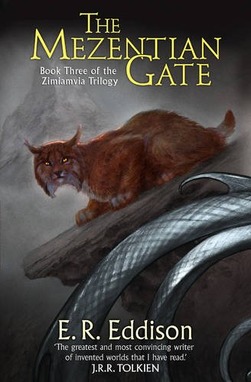 |
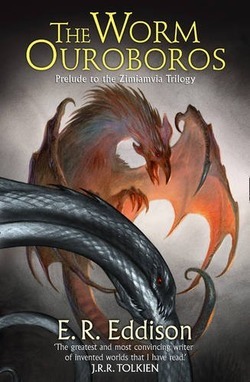 |
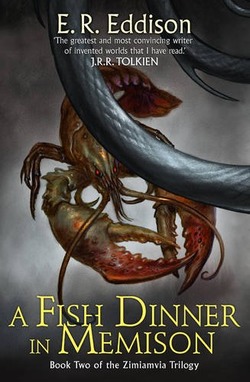 |
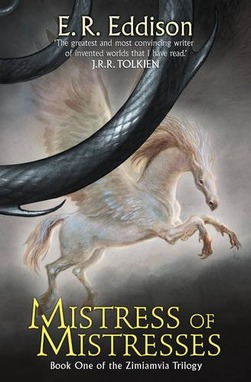 |
Many decades ago, I discovered four volumes of fantasy by the British author E. R. Eddison: The Worm Ouroboros, and its sequel, The Zimiamvia Trilogy (Mistress of Mistresses, A Fish Dinner in Memison, and the uncompleted The Mezentian Gate.) They were a handsome set of Ballantine paperbacks from 1967, all with gorgeous covers by Barbara Remington.
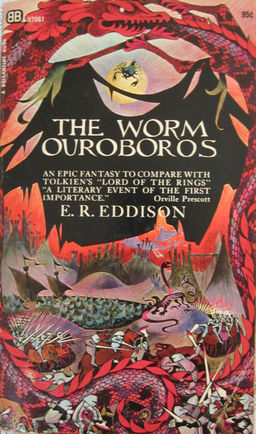 Eddison was a nearly forgotten writer, returned to print by the runaway success of J.R.R. Tolkien’s Lord of The Rings. There are many parallels between Tolkien’s masterpiece and Eddison’s fantasy epic, and in fact his work was admired by Tolkien — and some consider it the prototype for The Lord of the Rings, and indeed most modern fantasy.
Eddison was a nearly forgotten writer, returned to print by the runaway success of J.R.R. Tolkien’s Lord of The Rings. There are many parallels between Tolkien’s masterpiece and Eddison’s fantasy epic, and in fact his work was admired by Tolkien — and some consider it the prototype for The Lord of the Rings, and indeed most modern fantasy.
But Eddison’s novels never caught on the way Tolkien’s did. Ballantine tried one more time to introduce Eddison to American audiences with a paperback resissue under their Del Rey imprint in 1978 (this time with a matching set of covers by Murray Tinkelman, who had covered nearly a dozen Ballantine Lovecraft volumes), but after that they gave up. Dell issued a one-volume trade paperback of The Zimiamvia Trilogy in 1992, but it vanished without a trace.
In recent years, readers have begun to appreciate Eddison’s work. In the 1987 Locus poll for All-Time Best Fantasy Novel, The Worm Ouroboros placed 29th. A decade later, in the 1998 Locus poll for All-Time Best Fantasy Novel before 1990, it reached 23rd.
Still, despite its importance to fantasy, Eddison’s seminal series has been out of print in North America for over two decades.
Now comes word that Harper will be returning the books to print in a handsome four-volume set of trade paperbacks (click the images above for bigger versions). The cover art for each is quite striking, but together all four books form a beautiful mosaic, linked by the images of the worm Ouroboros.
Keep your eye out for the books this October.
See all of our recent Vintage Treasures here.
Oh, these look nice! My copies are the old Ballantines with those incredible Remington covers, but that never stopped me before…Eddison was a great writer, but his elaborate prose makes him more Like Cabell than Tolkien, and Cabell is another taste that will probably always be restricted to less than mass-market numbers. I’m always for another try, though – I’m sure there are plenty of people who’ve never heard of Eddison who would love him if they had a chance.
Also a prototype for Game of Thrones (in that we’ve been waiting for the completed version of the last book for almost 60 years …
I did read these (the ’67 paperback editions) back in the ’90s and found them very thick going but ultimately rewarding; I’ll be very happy to add the electronic versions to my Kindle.
I love those covers, but I do think it’s interesting how they’re laid out with Worm (the first book, sort of) in the top right and then continuing on clockwise.
Sprague de Camp had an interesting chapter about Eddison in his Literary Swordsmen and Sorcerers.
THE WORM OUROBOROS is one of those books that will divide fantasy readers into two camps: Those who love its intentionally antiquated style and archaic splendor of language–and those who will complain that it wasn’t written in a modern style with easy-of-reading as its foremost concern. The prose is ornate and baroque, which creates an effect that only heightens the fantastic reality where the adventure takes place. But, much like Shakespeare and Poe, it requires some effort from the reader. Some fantasy readers, I’ve found, enjoy this (I am one of them), while others would rather read something written in the last ten years, and so much for classic works of fantasy fiction. All this aside, there can be no real doubt abut it: THE WORM OUROBOROS is one of the greatest works of epic fantasy, period. This new version of the book (and its sequels) looks spectacular.
It’s worth pointing out that Eddison’s elaborate and archaic style was a conscious artistic choice. Very few people were writing like that, even in 1922 – there were probably plenty of people who found it unreadable even back then. The paradox is, because the language is so artificial, it actually doesn’t date the way that writing that tries to sound contemporary does. Myself, I love people like Eddison, Clark Ashton Smith, David Lindsay, and all the rest who wrote English as a Foreign Tongue.
Right-o, Thomas! Love those eldritch tomes…
I read through my omnibus copy of the Zimiavian Trilogy (annotated) during rare spare moments in basic and advanced training (US Army), oh so many years ago. I’d read “Worm” through a couple of times before. The contrast of Eddison’s prose and vision with my then current reality was both jarring and refreshing. Of course, as John Fultz and Thomas Parker point out, these books are not for everyone. As an inveterate Cabell aficionado it’s no surprise I enjoy Eddison’s baroque stylings.
Ken, I read One Hundred Years of Solitude and (re)read The Lord of the Rings by the DMZ in Korea. Nothing like a little fantasy to keep you warm when the freezing wind comes howling down from Manchuria…
> I’m sure there are plenty of people who’ve never heard of Eddison who would love him if they had a chance.
Thomas,
I think that’s exactly what Harper is banking on.
Still, I suspect there will be a lot more copies purchased than read. It would be great if Eddison could reach a whole new audience in the 21st Century. This is a considerable risk by Harper… I hope they’re successful.
>Also a prototype for Game of Thrones (in that we’ve been waiting for the completed version of the last book for almost 60 years …)
Joe,
Ha!
> Sprague de Camp had an interesting chapter about Eddison in his Literary Swordsmen and Sorcerers.
Oooo.. another reason why I need to stop dawdling, and buy a copy of that dang book.
> THE WORM OUROBOROS is one of those books that will divide fantasy readers into two camps: Those who love its
> intentionally antiquated style and archaic splendor of language–and those who will complain that it wasn’t written
> in a modern style with easy-of-reading as its foremost concern. The prose is ornate and baroque, which creates an
> effect that only heightens the fantastic reality where the adventure takes place. But, much like Shakespeare
> and Poe, it requires some effort from the reader.
Well said, John!
I know a lot of readers — young readers, mostly — who won’t intentionally touch fantasy written before they were born. Strange as it might sound, I think the field needs those kinds of readers as well… they’re excited by new writers, and they support them enthusiastically and uncritically. Without them, the field wouldn’t be as vibrant and attractive to new talent as it is.
I think those of us who appreciate and champion classic fantasy are in the minority… and that’s the way it should be. When the field stops looking forward, it dies.
> It’s worth pointing out that Eddison’s elaborate and archaic style was a conscious artistic choice…
> The paradox is, because the language is so artificial, it actually doesn’t date the way that writing
> that tries to sound contemporary does.
An excellent point, Thomas.
I hope it means Eddison is timeless enough to be successful with this generation. We’ll find out in October, I suppose. In the meantime, we do what we can to promote him here at Black Gate.
Ken said:
> I read through my omnibus copy of the Zimiavian Trilogy (annotated) during rare spare moments in basic and advanced
> training (US Army), oh so many years ago. I’d read “Worm” through a couple of times before. The contrast of Eddison’s
> prose and vision with my then current reality was both jarring and refreshing.
And Thomas said:
> I read One Hundred Years of Solitude and (re)read The Lord of the Rings by the DMZ in Korea. Nothing like a little
> fantasy to keep you warm when the freezing wind comes howling down from Manchuria…
I’ve always thought that fantasy was more readily appreciated by those in need of a little escapism (certainly that’s been true of me), but I never considered that an elaborate prose style might be attractive for the same reason. Thanks for sharing that, gentlemen!
Actually, from what I remember, the Zimiamvian books are also vaguely Martin-like in that they’re primarily concerned with military clashes and political intrigues.
And Eddison did at least have the final book outlined when he died — he just hadn’t gone in and fully fleshed-out his outline.
I do wonder if (get ready to cringe!) a publisher should consider giving new titles to at least a couple of the books, and putting the old titles in small letters: Formerly A Fish Dinner in Memison, Formerly: Mistress of Mistresses — and maybe even Formerly: The Mezentian Gate. Yes, I’m sure that many Black Gate readers would not feel put off by any of these titles. But for many readers, the titles will not evoke what, in fact, Eddison presumably set himself to provide, i.e. will actually be misleading.
I’m not even saying that I wish the renaming would be done — just raising the issue.
I read Worm as an undergraduate and enjoyed it, although it was work. I’m been toying with breaking with the sequence in my BAF series and give it a reread. I’ve got something up my sleeve for October, but maybe November or December…
And, yes, John (O’Neill), you do need to get a copy of that book.
John, John, and Thomas,
It is interesting how Eddison does fall into a category of enough writers from that early-twentieth-century period who consciously chose a dated, baroque style that it seems to have been a thing. Perhaps, as others have pointed out here, intended as a way of distancing the fantasy, adding an otherworldly veneer through the language as well as the setting. Indeed, that may be one facet of Tolkien’s LOTR that is not trumpeted enough: that he wrote his work in pretty modern, accessible prose (which is ironic in itself, if you know anything about Tolkien, his preferred reading, and his primary scholarly interests).
Thing about Eddison as opposed to Hodgson is that Eddison could get away with it. What I mean is, both The Worm Oroboros and The Night Land are considered seminal works of fantasy that are somewhat inaccessible to the masses because of the self-consciously ornate styles. However, Eddison is a helluva writer who can pull that artificial style off, whereas Hodgson’s prose turns clunky, stilted, and sometimes just ungrammatically nonsensical. In both cases, you have works that are wonders, powerfully enchanting narratives, but with Eddison the prose — if you can adjust to it — carries additional beauty in itself, another layer of the work to appreciate. Hodgson’s experiment in baroque English is a stumbling block to get past; Eddison’s is another source of enrichment.
Yes, I was very happy to see James Stoddard rewriting Night Land into something that actually resembles the English language, but I’d be kind of upset if someone tried to “modernize” Eddison.
Nick: You said it beautifully, man.
I tried reading The Worm Ourobouros, and what stopped me was the characterization, not the archaic style. I love a well-done archaic style, but even more than that, I love to be able to tell the characters apart by more than just their names. Fifty pages in, nobody but the narrator had a discernible personality.
Please, tell me it gets better.
[…] August, John O’Neill noted that HarperCollins would be reprinting four classic fantasies by E.R. Eddison: The Worm Ouroboros […]